Exploring Racism and its Effects on Indigenous Australians in Society
VerifiedAdded on 2021/04/21
|6
|1600
|32
Essay
AI Summary
This essay examines racism in Australia, focusing on its historical and contemporary manifestations, particularly concerning Aboriginal and Torres Strait Islander peoples. It explores structural and interpersonal racism, highlighting the impact on health, employment, and social experiences, using a case study of an Indigenous woman facing discrimination at a restaurant. The essay discusses the role of societal attitudes, media portrayals, and legal reforms in perpetuating or combating racism. It concludes that prejudiced mentalities and institutional practices contribute to discrimination, causing stress and health issues for Indigenous Australians. The essay references various studies and reports to support its arguments, emphasizing the need for proactive legal reforms to address the systemic issues of racism within Australian society.
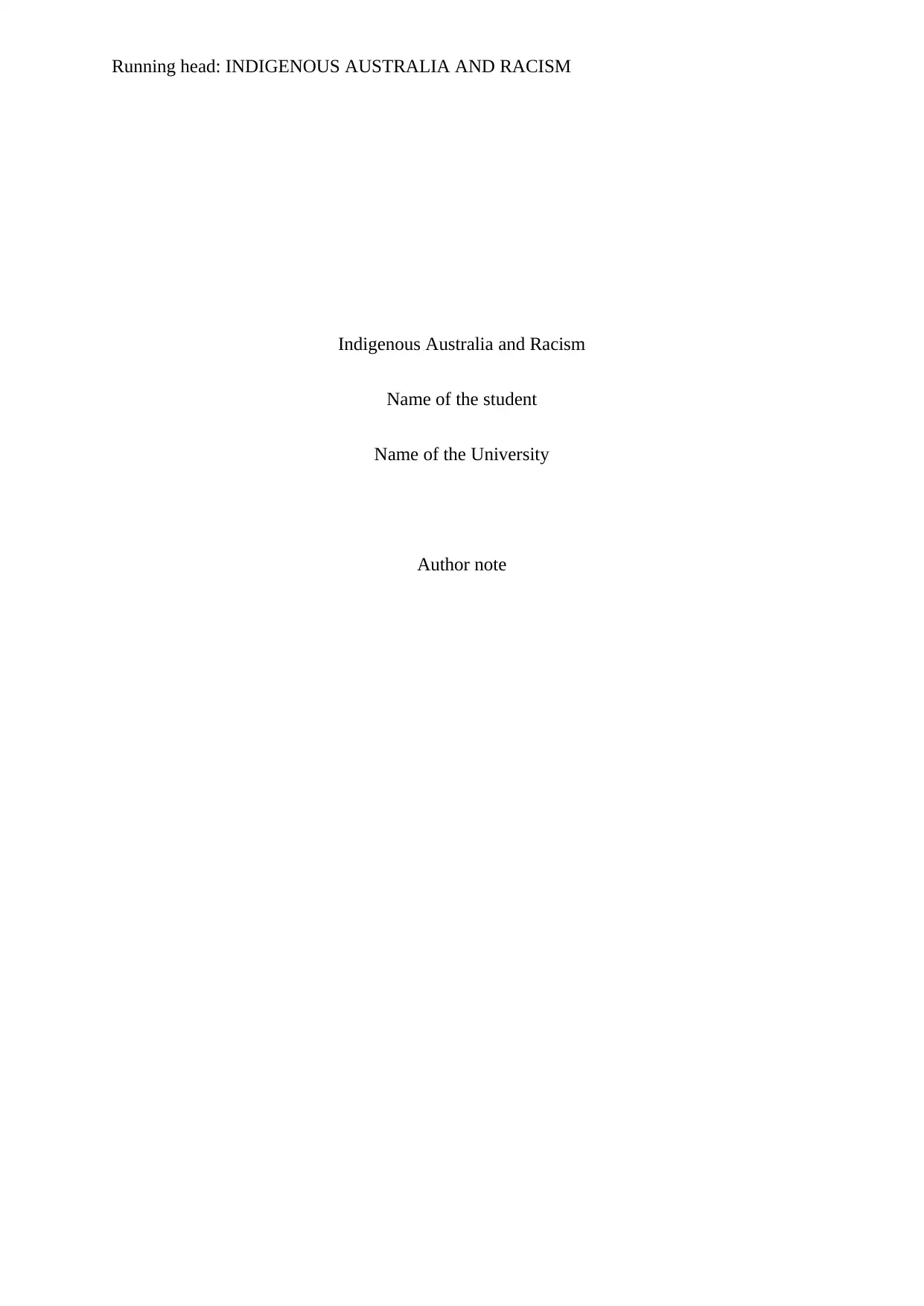
Running head: INDIGENOUS AUSTRALIA AND RACISM
Indigenous Australia and Racism
Name of the student
Name of the University
Author note
Indigenous Australia and Racism
Name of the student
Name of the University
Author note
Paraphrase This Document
Need a fresh take? Get an instant paraphrase of this document with our AI Paraphraser
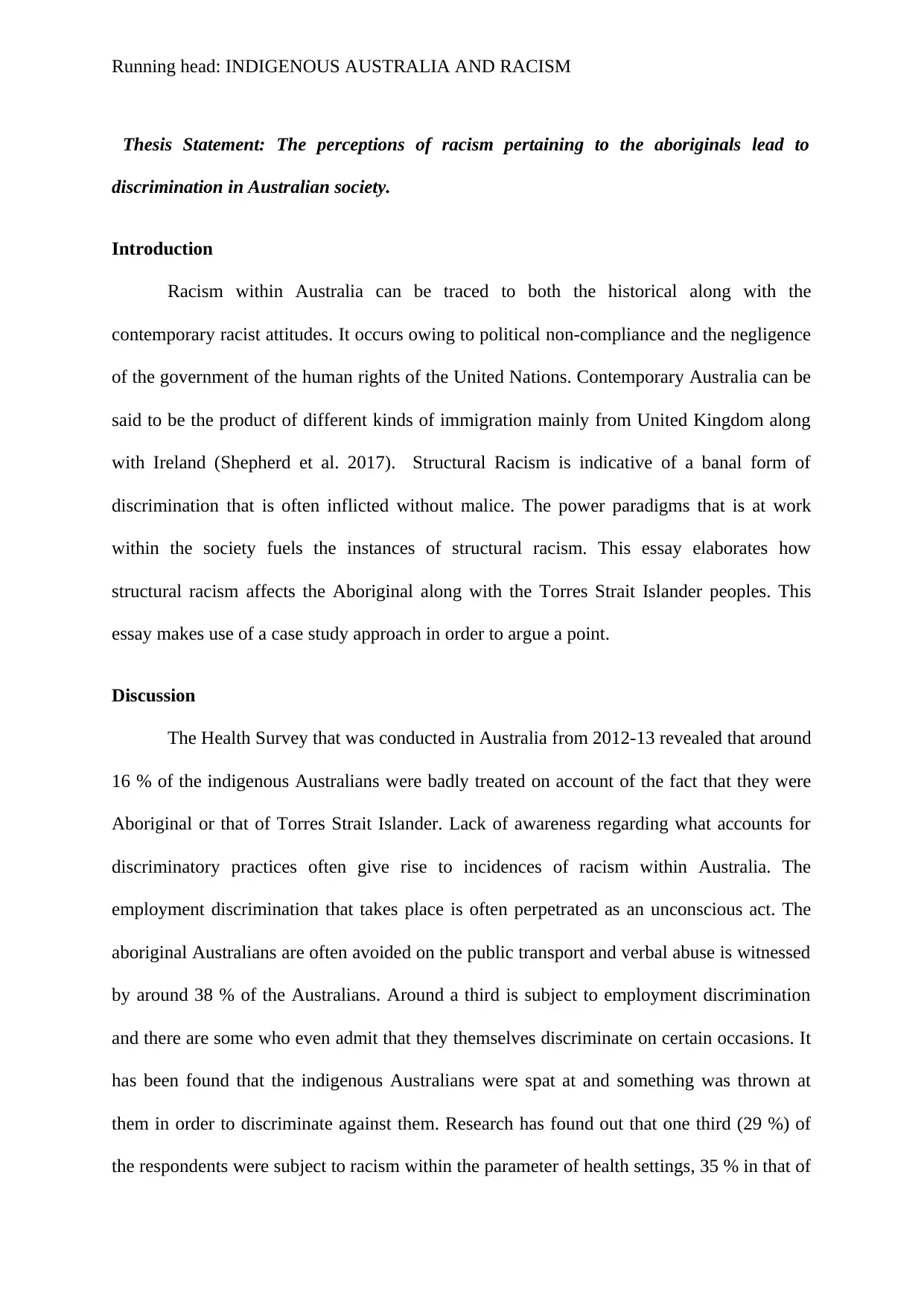
Running head: INDIGENOUS AUSTRALIA AND RACISM
Thesis Statement: The perceptions of racism pertaining to the aboriginals lead to
discrimination in Australian society.
Introduction
Racism within Australia can be traced to both the historical along with the
contemporary racist attitudes. It occurs owing to political non-compliance and the negligence
of the government of the human rights of the United Nations. Contemporary Australia can be
said to be the product of different kinds of immigration mainly from United Kingdom along
with Ireland (Shepherd et al. 2017). Structural Racism is indicative of a banal form of
discrimination that is often inflicted without malice. The power paradigms that is at work
within the society fuels the instances of structural racism. This essay elaborates how
structural racism affects the Aboriginal along with the Torres Strait Islander peoples. This
essay makes use of a case study approach in order to argue a point.
Discussion
The Health Survey that was conducted in Australia from 2012-13 revealed that around
16 % of the indigenous Australians were badly treated on account of the fact that they were
Aboriginal or that of Torres Strait Islander. Lack of awareness regarding what accounts for
discriminatory practices often give rise to incidences of racism within Australia. The
employment discrimination that takes place is often perpetrated as an unconscious act. The
aboriginal Australians are often avoided on the public transport and verbal abuse is witnessed
by around 38 % of the Australians. Around a third is subject to employment discrimination
and there are some who even admit that they themselves discriminate on certain occasions. It
has been found that the indigenous Australians were spat at and something was thrown at
them in order to discriminate against them. Research has found out that one third (29 %) of
the respondents were subject to racism within the parameter of health settings, 35 % in that of
Thesis Statement: The perceptions of racism pertaining to the aboriginals lead to
discrimination in Australian society.
Introduction
Racism within Australia can be traced to both the historical along with the
contemporary racist attitudes. It occurs owing to political non-compliance and the negligence
of the government of the human rights of the United Nations. Contemporary Australia can be
said to be the product of different kinds of immigration mainly from United Kingdom along
with Ireland (Shepherd et al. 2017). Structural Racism is indicative of a banal form of
discrimination that is often inflicted without malice. The power paradigms that is at work
within the society fuels the instances of structural racism. This essay elaborates how
structural racism affects the Aboriginal along with the Torres Strait Islander peoples. This
essay makes use of a case study approach in order to argue a point.
Discussion
The Health Survey that was conducted in Australia from 2012-13 revealed that around
16 % of the indigenous Australians were badly treated on account of the fact that they were
Aboriginal or that of Torres Strait Islander. Lack of awareness regarding what accounts for
discriminatory practices often give rise to incidences of racism within Australia. The
employment discrimination that takes place is often perpetrated as an unconscious act. The
aboriginal Australians are often avoided on the public transport and verbal abuse is witnessed
by around 38 % of the Australians. Around a third is subject to employment discrimination
and there are some who even admit that they themselves discriminate on certain occasions. It
has been found that the indigenous Australians were spat at and something was thrown at
them in order to discriminate against them. Research has found out that one third (29 %) of
the respondents were subject to racism within the parameter of health settings, 35 % in that of
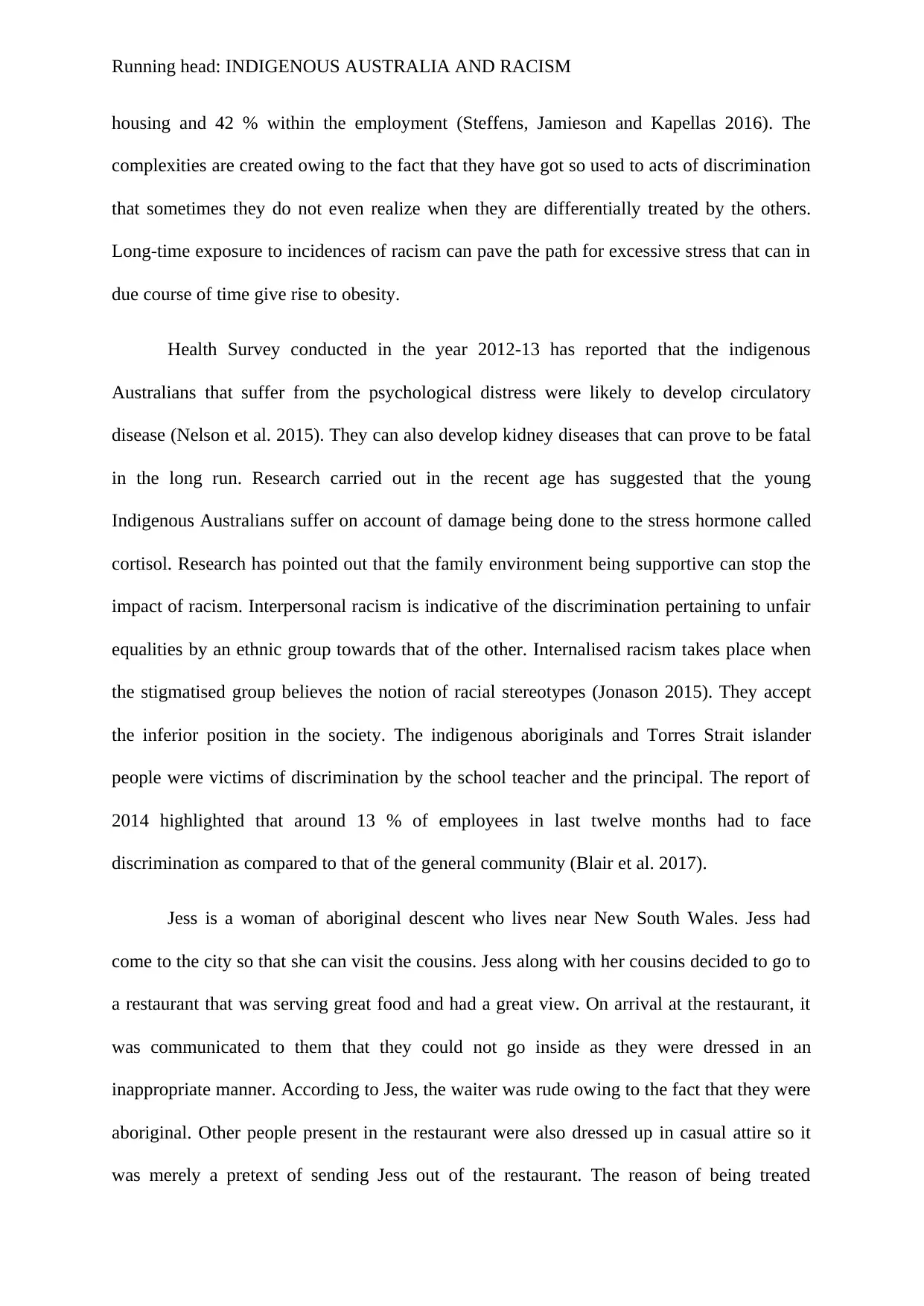
Running head: INDIGENOUS AUSTRALIA AND RACISM
housing and 42 % within the employment (Steffens, Jamieson and Kapellas 2016). The
complexities are created owing to the fact that they have got so used to acts of discrimination
that sometimes they do not even realize when they are differentially treated by the others.
Long-time exposure to incidences of racism can pave the path for excessive stress that can in
due course of time give rise to obesity.
Health Survey conducted in the year 2012-13 has reported that the indigenous
Australians that suffer from the psychological distress were likely to develop circulatory
disease (Nelson et al. 2015). They can also develop kidney diseases that can prove to be fatal
in the long run. Research carried out in the recent age has suggested that the young
Indigenous Australians suffer on account of damage being done to the stress hormone called
cortisol. Research has pointed out that the family environment being supportive can stop the
impact of racism. Interpersonal racism is indicative of the discrimination pertaining to unfair
equalities by an ethnic group towards that of the other. Internalised racism takes place when
the stigmatised group believes the notion of racial stereotypes (Jonason 2015). They accept
the inferior position in the society. The indigenous aboriginals and Torres Strait islander
people were victims of discrimination by the school teacher and the principal. The report of
2014 highlighted that around 13 % of employees in last twelve months had to face
discrimination as compared to that of the general community (Blair et al. 2017).
Jess is a woman of aboriginal descent who lives near New South Wales. Jess had
come to the city so that she can visit the cousins. Jess along with her cousins decided to go to
a restaurant that was serving great food and had a great view. On arrival at the restaurant, it
was communicated to them that they could not go inside as they were dressed in an
inappropriate manner. According to Jess, the waiter was rude owing to the fact that they were
aboriginal. Other people present in the restaurant were also dressed up in casual attire so it
was merely a pretext of sending Jess out of the restaurant. The reason of being treated
housing and 42 % within the employment (Steffens, Jamieson and Kapellas 2016). The
complexities are created owing to the fact that they have got so used to acts of discrimination
that sometimes they do not even realize when they are differentially treated by the others.
Long-time exposure to incidences of racism can pave the path for excessive stress that can in
due course of time give rise to obesity.
Health Survey conducted in the year 2012-13 has reported that the indigenous
Australians that suffer from the psychological distress were likely to develop circulatory
disease (Nelson et al. 2015). They can also develop kidney diseases that can prove to be fatal
in the long run. Research carried out in the recent age has suggested that the young
Indigenous Australians suffer on account of damage being done to the stress hormone called
cortisol. Research has pointed out that the family environment being supportive can stop the
impact of racism. Interpersonal racism is indicative of the discrimination pertaining to unfair
equalities by an ethnic group towards that of the other. Internalised racism takes place when
the stigmatised group believes the notion of racial stereotypes (Jonason 2015). They accept
the inferior position in the society. The indigenous aboriginals and Torres Strait islander
people were victims of discrimination by the school teacher and the principal. The report of
2014 highlighted that around 13 % of employees in last twelve months had to face
discrimination as compared to that of the general community (Blair et al. 2017).
Jess is a woman of aboriginal descent who lives near New South Wales. Jess had
come to the city so that she can visit the cousins. Jess along with her cousins decided to go to
a restaurant that was serving great food and had a great view. On arrival at the restaurant, it
was communicated to them that they could not go inside as they were dressed in an
inappropriate manner. According to Jess, the waiter was rude owing to the fact that they were
aboriginal. Other people present in the restaurant were also dressed up in casual attire so it
was merely a pretext of sending Jess out of the restaurant. The reason of being treated
⊘ This is a preview!⊘
Do you want full access?
Subscribe today to unlock all pages.

Trusted by 1+ million students worldwide
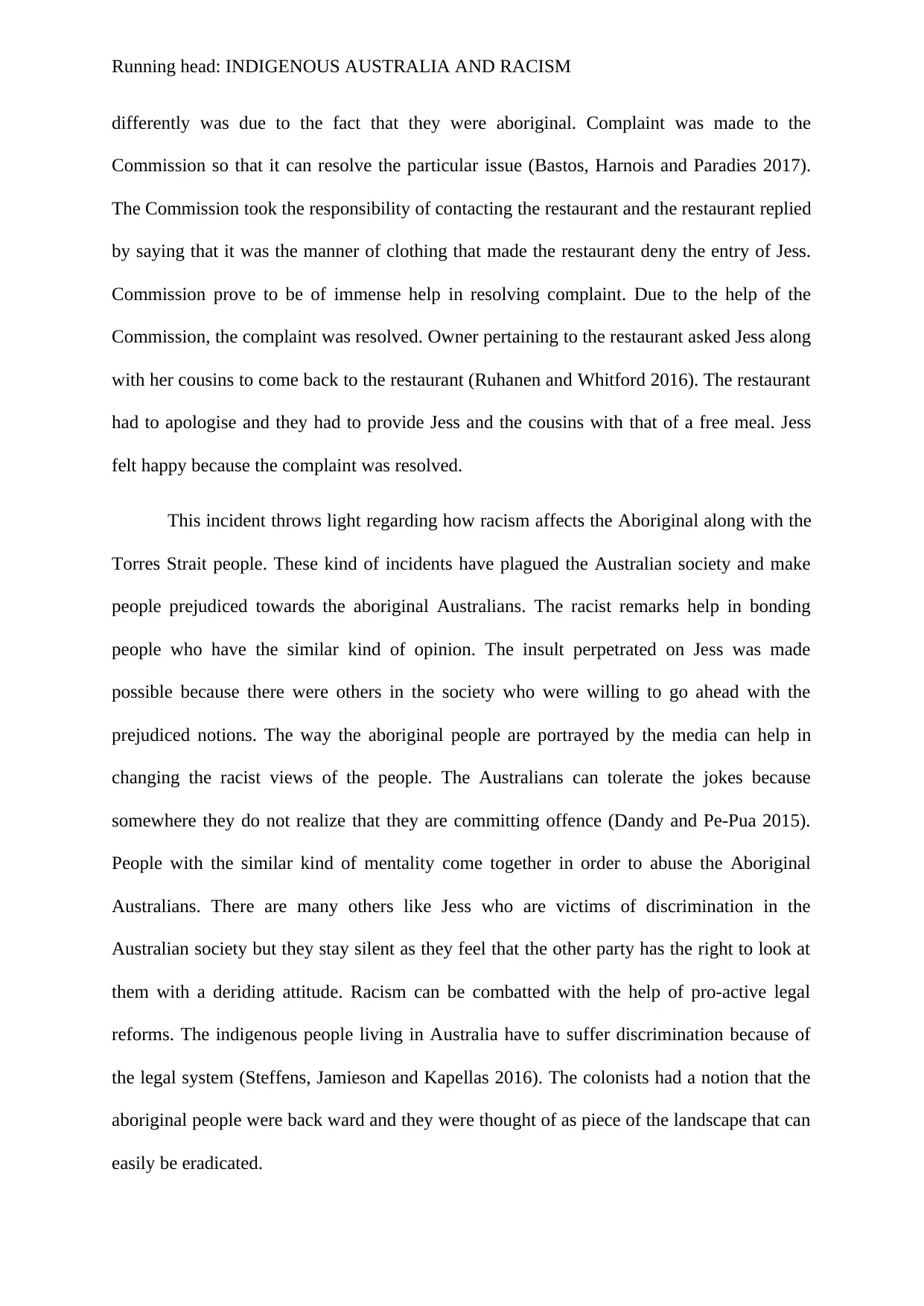
Running head: INDIGENOUS AUSTRALIA AND RACISM
differently was due to the fact that they were aboriginal. Complaint was made to the
Commission so that it can resolve the particular issue (Bastos, Harnois and Paradies 2017).
The Commission took the responsibility of contacting the restaurant and the restaurant replied
by saying that it was the manner of clothing that made the restaurant deny the entry of Jess.
Commission prove to be of immense help in resolving complaint. Due to the help of the
Commission, the complaint was resolved. Owner pertaining to the restaurant asked Jess along
with her cousins to come back to the restaurant (Ruhanen and Whitford 2016). The restaurant
had to apologise and they had to provide Jess and the cousins with that of a free meal. Jess
felt happy because the complaint was resolved.
This incident throws light regarding how racism affects the Aboriginal along with the
Torres Strait people. These kind of incidents have plagued the Australian society and make
people prejudiced towards the aboriginal Australians. The racist remarks help in bonding
people who have the similar kind of opinion. The insult perpetrated on Jess was made
possible because there were others in the society who were willing to go ahead with the
prejudiced notions. The way the aboriginal people are portrayed by the media can help in
changing the racist views of the people. The Australians can tolerate the jokes because
somewhere they do not realize that they are committing offence (Dandy and Pe-Pua 2015).
People with the similar kind of mentality come together in order to abuse the Aboriginal
Australians. There are many others like Jess who are victims of discrimination in the
Australian society but they stay silent as they feel that the other party has the right to look at
them with a deriding attitude. Racism can be combatted with the help of pro-active legal
reforms. The indigenous people living in Australia have to suffer discrimination because of
the legal system (Steffens, Jamieson and Kapellas 2016). The colonists had a notion that the
aboriginal people were back ward and they were thought of as piece of the landscape that can
easily be eradicated.
differently was due to the fact that they were aboriginal. Complaint was made to the
Commission so that it can resolve the particular issue (Bastos, Harnois and Paradies 2017).
The Commission took the responsibility of contacting the restaurant and the restaurant replied
by saying that it was the manner of clothing that made the restaurant deny the entry of Jess.
Commission prove to be of immense help in resolving complaint. Due to the help of the
Commission, the complaint was resolved. Owner pertaining to the restaurant asked Jess along
with her cousins to come back to the restaurant (Ruhanen and Whitford 2016). The restaurant
had to apologise and they had to provide Jess and the cousins with that of a free meal. Jess
felt happy because the complaint was resolved.
This incident throws light regarding how racism affects the Aboriginal along with the
Torres Strait people. These kind of incidents have plagued the Australian society and make
people prejudiced towards the aboriginal Australians. The racist remarks help in bonding
people who have the similar kind of opinion. The insult perpetrated on Jess was made
possible because there were others in the society who were willing to go ahead with the
prejudiced notions. The way the aboriginal people are portrayed by the media can help in
changing the racist views of the people. The Australians can tolerate the jokes because
somewhere they do not realize that they are committing offence (Dandy and Pe-Pua 2015).
People with the similar kind of mentality come together in order to abuse the Aboriginal
Australians. There are many others like Jess who are victims of discrimination in the
Australian society but they stay silent as they feel that the other party has the right to look at
them with a deriding attitude. Racism can be combatted with the help of pro-active legal
reforms. The indigenous people living in Australia have to suffer discrimination because of
the legal system (Steffens, Jamieson and Kapellas 2016). The colonists had a notion that the
aboriginal people were back ward and they were thought of as piece of the landscape that can
easily be eradicated.
Paraphrase This Document
Need a fresh take? Get an instant paraphrase of this document with our AI Paraphraser
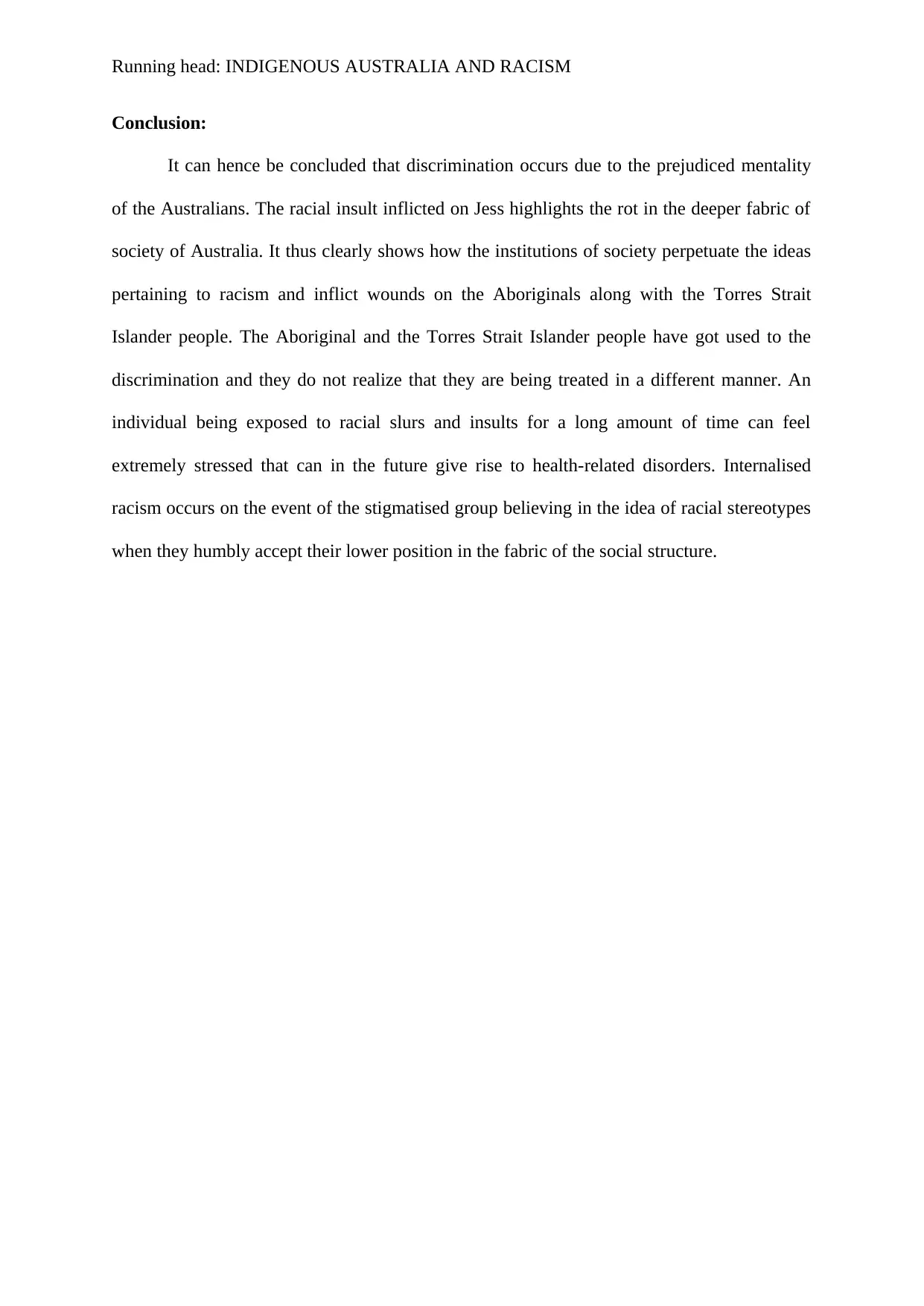
Running head: INDIGENOUS AUSTRALIA AND RACISM
Conclusion:
It can hence be concluded that discrimination occurs due to the prejudiced mentality
of the Australians. The racial insult inflicted on Jess highlights the rot in the deeper fabric of
society of Australia. It thus clearly shows how the institutions of society perpetuate the ideas
pertaining to racism and inflict wounds on the Aboriginals along with the Torres Strait
Islander people. The Aboriginal and the Torres Strait Islander people have got used to the
discrimination and they do not realize that they are being treated in a different manner. An
individual being exposed to racial slurs and insults for a long amount of time can feel
extremely stressed that can in the future give rise to health-related disorders. Internalised
racism occurs on the event of the stigmatised group believing in the idea of racial stereotypes
when they humbly accept their lower position in the fabric of the social structure.
Conclusion:
It can hence be concluded that discrimination occurs due to the prejudiced mentality
of the Australians. The racial insult inflicted on Jess highlights the rot in the deeper fabric of
society of Australia. It thus clearly shows how the institutions of society perpetuate the ideas
pertaining to racism and inflict wounds on the Aboriginals along with the Torres Strait
Islander people. The Aboriginal and the Torres Strait Islander people have got used to the
discrimination and they do not realize that they are being treated in a different manner. An
individual being exposed to racial slurs and insults for a long amount of time can feel
extremely stressed that can in the future give rise to health-related disorders. Internalised
racism occurs on the event of the stigmatised group believing in the idea of racial stereotypes
when they humbly accept their lower position in the fabric of the social structure.
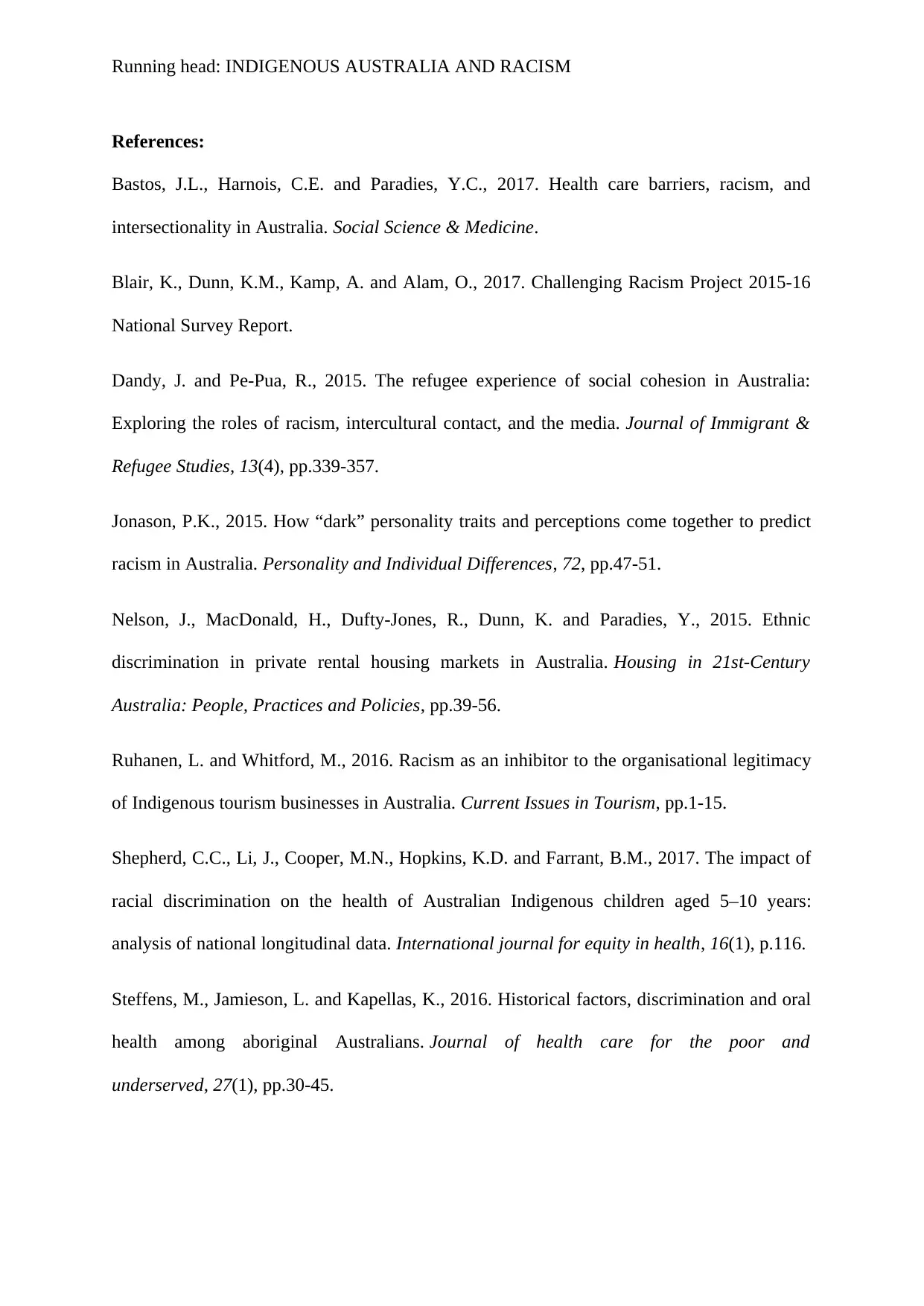
Running head: INDIGENOUS AUSTRALIA AND RACISM
References:
Bastos, J.L., Harnois, C.E. and Paradies, Y.C., 2017. Health care barriers, racism, and
intersectionality in Australia. Social Science & Medicine.
Blair, K., Dunn, K.M., Kamp, A. and Alam, O., 2017. Challenging Racism Project 2015-16
National Survey Report.
Dandy, J. and Pe-Pua, R., 2015. The refugee experience of social cohesion in Australia:
Exploring the roles of racism, intercultural contact, and the media. Journal of Immigrant &
Refugee Studies, 13(4), pp.339-357.
Jonason, P.K., 2015. How “dark” personality traits and perceptions come together to predict
racism in Australia. Personality and Individual Differences, 72, pp.47-51.
Nelson, J., MacDonald, H., Dufty-Jones, R., Dunn, K. and Paradies, Y., 2015. Ethnic
discrimination in private rental housing markets in Australia. Housing in 21st-Century
Australia: People, Practices and Policies, pp.39-56.
Ruhanen, L. and Whitford, M., 2016. Racism as an inhibitor to the organisational legitimacy
of Indigenous tourism businesses in Australia. Current Issues in Tourism, pp.1-15.
Shepherd, C.C., Li, J., Cooper, M.N., Hopkins, K.D. and Farrant, B.M., 2017. The impact of
racial discrimination on the health of Australian Indigenous children aged 5–10 years:
analysis of national longitudinal data. International journal for equity in health, 16(1), p.116.
Steffens, M., Jamieson, L. and Kapellas, K., 2016. Historical factors, discrimination and oral
health among aboriginal Australians. Journal of health care for the poor and
underserved, 27(1), pp.30-45.
References:
Bastos, J.L., Harnois, C.E. and Paradies, Y.C., 2017. Health care barriers, racism, and
intersectionality in Australia. Social Science & Medicine.
Blair, K., Dunn, K.M., Kamp, A. and Alam, O., 2017. Challenging Racism Project 2015-16
National Survey Report.
Dandy, J. and Pe-Pua, R., 2015. The refugee experience of social cohesion in Australia:
Exploring the roles of racism, intercultural contact, and the media. Journal of Immigrant &
Refugee Studies, 13(4), pp.339-357.
Jonason, P.K., 2015. How “dark” personality traits and perceptions come together to predict
racism in Australia. Personality and Individual Differences, 72, pp.47-51.
Nelson, J., MacDonald, H., Dufty-Jones, R., Dunn, K. and Paradies, Y., 2015. Ethnic
discrimination in private rental housing markets in Australia. Housing in 21st-Century
Australia: People, Practices and Policies, pp.39-56.
Ruhanen, L. and Whitford, M., 2016. Racism as an inhibitor to the organisational legitimacy
of Indigenous tourism businesses in Australia. Current Issues in Tourism, pp.1-15.
Shepherd, C.C., Li, J., Cooper, M.N., Hopkins, K.D. and Farrant, B.M., 2017. The impact of
racial discrimination on the health of Australian Indigenous children aged 5–10 years:
analysis of national longitudinal data. International journal for equity in health, 16(1), p.116.
Steffens, M., Jamieson, L. and Kapellas, K., 2016. Historical factors, discrimination and oral
health among aboriginal Australians. Journal of health care for the poor and
underserved, 27(1), pp.30-45.
⊘ This is a preview!⊘
Do you want full access?
Subscribe today to unlock all pages.

Trusted by 1+ million students worldwide
1 out of 6
Related Documents
Your All-in-One AI-Powered Toolkit for Academic Success.
+13062052269
info@desklib.com
Available 24*7 on WhatsApp / Email
![[object Object]](/_next/static/media/star-bottom.7253800d.svg)
Unlock your academic potential
Copyright © 2020–2025 A2Z Services. All Rights Reserved. Developed and managed by ZUCOL.





